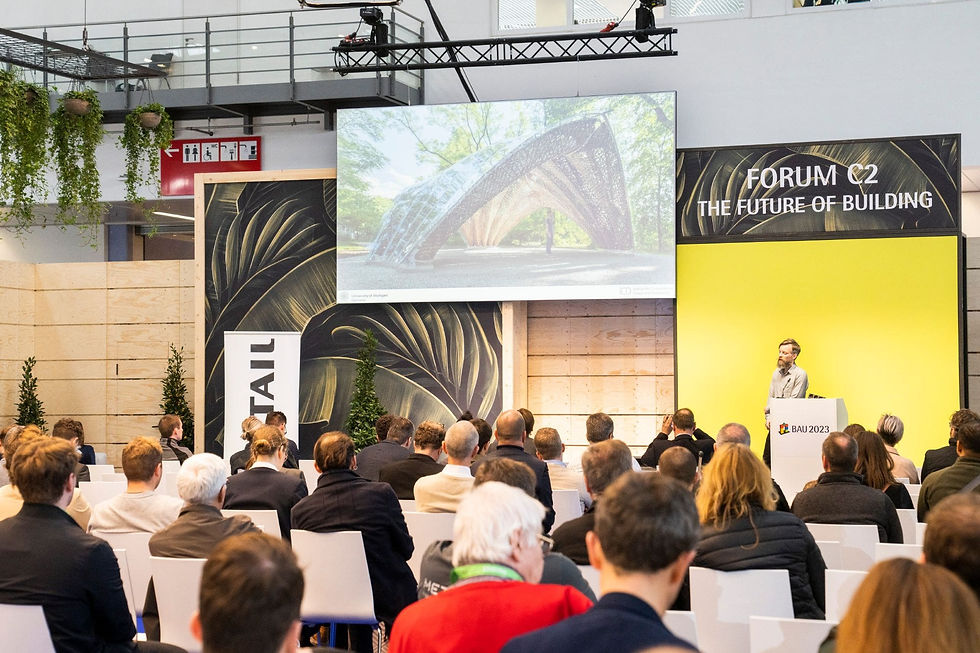Impressions: BAU 2023 World's Leading Trade Fair for Architecture, Materials, Systems
- nataliekandlhofer
- Apr 27, 2023
- 4 min read
In Munich, BAU 2023 was held after a gap of more than four years, with a special emphasis on digital transformation and energy efficiency. The event showcased various topics such as "climate change challenge," "modular, serial, prefabricated construction," "resources and recycling," and "the future of living." The exhibition space, covering around 200.000 square meters, hosted approximately 2.000 exhibitors who showcased their latest solutions to address current and future challenges. My objective was to determine the industry's current focus on sustainability, and I was pleasantly surprised by the confidence with which the industry approaches the future.

In the spirit of sustainability
Sustainability is a buzzword that seems to be everywhere these days, but does it truly go beyond the surface level? The term "greenwashing" comes to mind, highlighting the need for deeper consideration. Although there is certainly confidence in sustainable construction, it's not just up to builders to implement it. Society and experts (with a focus on education) must also play a role.
I set out to find out how 3D building models can be used to renovate sustainably and energy efficiently. Since my strict schedule only allowed me one day at the fair, and as mentioned above, the area was huge, my findings were not quite what I was initially looking for. But I was able to discover other interesting things.
The image of sustainable construction
Sustainable construction often gets a bad rap when it comes to its economic viability. Many claim that sustainable construction is too costly. While this may be true in the short term, opinions are divided when looking at the future.
"I am building energy-efficiently. So I am also building sustainably" - yes and no. Energy efficiency in itself is sustainable, but one must also consider the materials used to achieve this energy efficiency: this starts with resource procurement and manufacturing, goes through the lifespan, and ends with disposal. The most effective insulation is not sustainable if the material is produced expensively or releases pollutants during use or disposal - in short, if the materials used have a large ecological footprint.
This is the primary challenge when it comes to sustainable construction - it's not only about the present but also about the future, leading us to the importance of circular construction.
Circular Building
Have you ever come across the term "circular construction"? The word "circular" implies that this type of construction follows a cycle. Essentially, circular building involves recycling building materials that were previously used and would have become waste during demolition, repurposing them for new building projects. This approach seems highly sustainable, doesn't it?
If you're thinking that this construction method must be incredibly costly, I would suggest considering the expenses incurred by not adopting such measures. Now, let's focus on the primary question, which is how to utilize digital 3D building models to renovate buildings in a sustainable and energy-efficient manner.
Digital Transformation
Digitalization has gradually impacted the construction industry, albeit with a delay. Artificial intelligence (AI) is gaining significance in this field, resulting in increased use of tools such as robotics and machine learning.
Robotic technology is being implemented in both production and construction sites. Unlike machine learning, robots and machines are utilized to perform precise tasks, opening up new possibilities, particularly in design and construction.
Machine learning involves computers learning from data without requiring explicit programming. By recognizing specific patterns in the provided data, the computer can create predictions. This approach can be implemented in various fields, such as predicting construction costs, quality control, and even safety on construction sites.
However, this still doesn't answer the primary question of how to utilize 3D building models to achieve energy-efficient renovation. Do you follow my train of thought?
The value of 3D building models lies not in the model itself, but in how it interacts with various new/digital tools. The construction industry cannot avoid the digital revolution, which is ultimately beneficial. Digitalization provides a significant advantage in meeting the high demands placed on our buildings. It enables us to maintain an overview, and this is where the digital 3D model comes in. It is a crucial starting point that guides us through everything that the digital construction world has to offer.
Modular, Serial, and Prefabricated Construction and the Future of Housing
As the world population continues to increase, housing shortages and rising rent prices are becoming a pressing issue. I went on a quest to find out where the problem lies, and I think I've found it: people in economically strong nations are accustomed to a high standard of living. New buildings are constantly being constructed, the land is being sealed off, and too many people still believe that bigger and more massive is better, possibly for prestige reasons. But is such extravagance truly necessary for comfortable living, or is it just a product of societal expectations?
This is where modular construction comes in, with its focus on location independence, manageable size, and cost-effectiveness through serial production. As expected, digital 3D models also play a crucial role in this innovative approach to construction.
Challenge of Climate Change
In recent years, the effects of climate change such as heat waves, long dry spells, wildfires, storms, heavy rains and floods have become more pronounced. The construction industry has a significant role to play in addressing climate change in two ways. Firstly, it needs to develop solutions to protect against extreme weather caprices. Secondly, the industry can help prevent these events from occurring in the first place by reducing its environmental impact. Ultimately, we have the power to make a difference.
Are you interested in the topic of 3D modeling (BIM) and want to learn more about it or do you have specific questions? We would be happy to have a conversation about it.
Michael Danklmaier
Miviso Co-Founder
Tel.: +43 664 4563309
Photo: Messe München




Comments